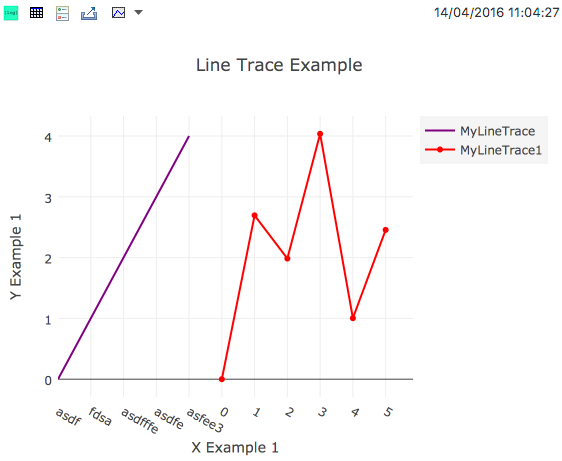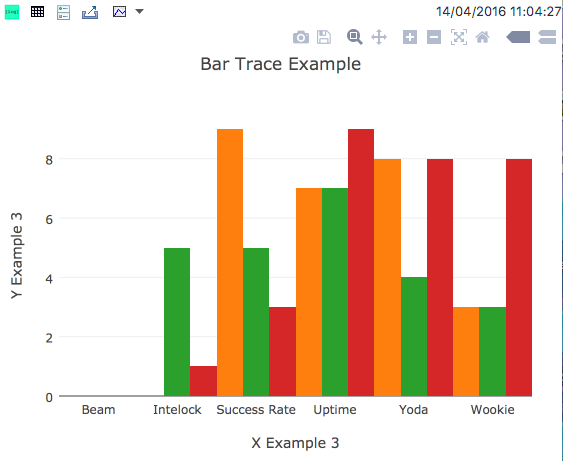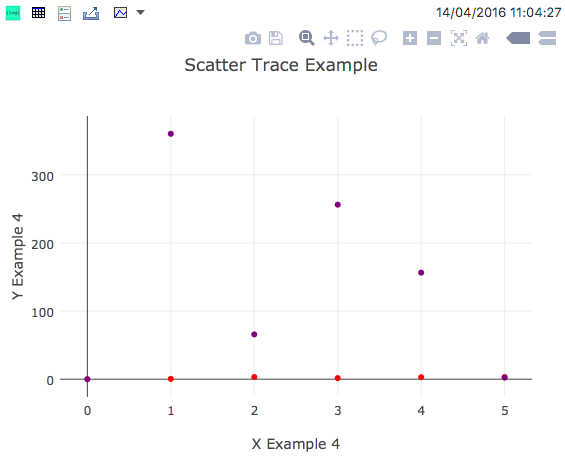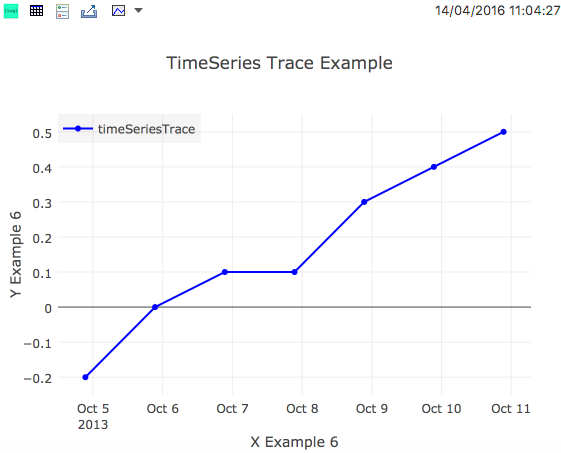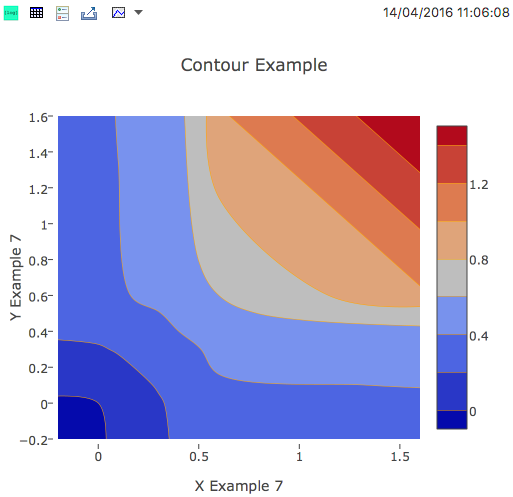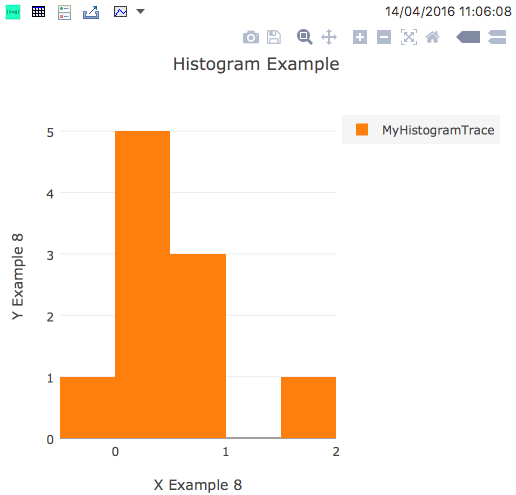For using the dataviewer in your browser
For JavaFX + browser
- https://github.com/jasrodis/javafx-dataviewer-wrapper
- https://github.com/jasrodis/javafx-dataviewer-example
Dataviewer is an open-source data visualization tool for JavaFX.
It is based on Plotly.js, JavaFx, Jetty and Websockets.
- Recent version of Java installed supporting JavaFX.
Maven installation :
<dependency>
<groupId>charts</groupId>
<artifactId>javafx-dataviewer</artifactId>
<version>{latest.version}</version>
</dependency>
- DataViewer
- DataViewerConfiguration
- Trace
- TraceConfiguration
- PlotData
DataViewer is the main plotting window. It is configured by the DataViewerConfiguration.
With DataViewer you can :
- Update your Plot Configuration
- Update your Plot Data
- Reset your Plot Data
updatePlot(PlotData data); // Updates the plot
updatePlotConfiguration(DataViewerConfiguration config); // Updates the dataviewer (window) configuration.
getUniqueID(); // Get the unique ID of the dataviewer - // navigate http://localhost:8090/view/UNIQUE_ID/
setPlotTitle(String title); // plot title
setxAxisTitle(String title); // x axis title
setyAxisTitle(String title); // x axis title
setMarginTop(int margin); // margin top
setMarginBottom(int margin); // margin bottom
setMarginRight(int margin); // margin right
setMarginLeft(int margin); // margin left
setPadding(int padding); // padding
setxRange(double min, double max); // Set the range of the x axis of the dataviewer
setyRange(double min, double max); // Set the range of the x axis of the dataviewer
setxAxisType(AxisType type); // Set the axis type of x axis (log or linear)
setyAxisType(AxisType type); // Set the axis type of y axis (log or linear)
showLegend(boolean set); // Show/hide Legend
setLegendInsidePlot(boolean inside); // Show legend inside plot
See usage example below:
// Create dataviewer
DataViewer dataviewer = new DataViewer();
// Create dataviewer configuration
DataViewerConfiguration config = new DataViewerConfiguration();
// Plot title
config.setPlotTitle("Line Trace Example");
// X axis title
config.setxAxisTitle("X Example 1");
// Y axis title
config.setyAxisTitle("Y Example 1");
// Update the configuration
dataviewer.sendConfiguration(config);
// Container of traces
PlotData plotData = new PlotData(new LineTrace<Float>());
// Plot all traces in the container.
dataviewer.updatePlot(plotData);
Resetting the dataviewer example:
DataViewer dataviewer = new DataViewer();
DataViewerConfiguration config = new DataViewerConfiguration();
dataviewer.sendConfiguration(config);
PlotData plotData = new PlotData();
dataviewer.updatePlot(plotData);
// Reset your Plot (removes all trace from the dataviewer)
dataviewer.resetPlot();
Traces are the different kind of plots that are going to be drawed in the DataViewer. Provided Traces:
- GenericTrace
- LineTrace
- ScatterTrace
- BarTrace
- TimeSeriesTrace
- HistogramTrace
- ContourTrace
More to be provided..
GenericTrace is an abstract class that all traces inherit from.
It can be used as a container when the type of the trace is not known.
See usage example below:
Methods:
// Config
setTraceName(String traceName); // Updates the plot
setConfiguration(TraceConfiguration traceConfig) // Set the trace configuration
setTraceColour(TraceColour colour); // Set trace Colour
setTraceMode(TraceMode mode); // Set the trace mode (LINES, MARKERS, MARKERS_AND_LINES)
setTraceType(TraceType traceType); // Set the trace Type (BAR, LINE, SCATTER, CONTOUR ...)
setTraceVisibility(TraceVisibility visibility); // Visibility of the trace(TRUE, FALSE, LEGENDONLY)
// Data
setxAxis(T[] xAxis);
setyAxis(T[] xAxis);
setzAxis(T[] zAxis);
GenericTrace<Double> genericTrace = new LineTrace<>();
genericTrace.setxArray(new Double[] { 0.0, 1.0, 2.0, 3.0, 4.0, 5.0 });
genericTrace.setyArray(new Double[] { 0.0, 1.0, 2.0, 3.0, 4.0, 5.0 });
genericTrace.setTraceColour(TraceColour.PURPLE);
genericTrace.setTraceName("Line Trace");
genericTrace.setTraceType(TraceType.LINE);
genericTrace.setTraceMode(TraceMode.LINES);
genericTrace.setTraceVisibility(TraceVisibility.TRUE);
Example:
LineTrace<Double> lineTrace = new LineTrace<>();
lineTrace.setTraceName("MyLineTrace");
lineTrace.setxArray(new Double[] { 0.0, 1.0, 2.0, 3.0, 4.0, 5.0 });
lineTrace.setyArray(new Double[] { 0.0, 1.0, 2.0, 3.0, 4.0, 5.0 });
lineTrace.setTraceColour(TraceColour.PURPLE);
Example with configuration object:
LineTrace<Double> lineTrace = new LineTrace<>();
lineTrace.setTraceName("MyLineTrace");
lineTrace.setxArray(new Double[] { 0.0, 1.0, 2.0, 3.0, 4.0, 5.0 });
lineTrace.setyArray(new Double[] { 0.0, 1.0, 2.0, 3.0, 4.0, 5.0 });
TraceConfiguration lineConfig = new TraceConfiguration();
lineConfig.setTraceColour(TraceColour.RED);
lineTrace.setConfiguration(lineConfig);
Example:
BarTrace<Object> barTrace = new BarTrace<>();
barTrace.setTraceName("MyBarTrace");
barTrace.setxArray(new String[] { "one", "two", "three", "four", "five", "six" });
barTrace.setyArray(new Double[] { 0.0, 1.0, 2.0, 3.0, 4.0, 5.0 });
barTrace.setTraceColour(TraceColour.PURPLE);
Example with configuration object:
BarTrace<Object> barTrace = new BarTrace<>();
barTrace.setTraceName("MyBarTrace");
barTrace.setxArray(new String[] { "one", "two", "three", "four", "five", "six" });
barTrace.setyArray(new Double[] { 0.0, 1.0, 2.0, 3.0, 4.0, 5.0 });
TraceConfiguration barConfig = new TraceConfiguration();
barConfig.setTraceColour(TraceColour.RED);
barTrace.setConfiguration(barConfig);
Example:
Scatter<Float> scatterTrace = new ScatterTrace<>();
scatterTrace.setTraceName("MyScatterTrace");
scatterTrace.setxArray(new Float[] { 0.0, 1.0, 2.0, 3.0, 4.0, 5.0 });
scatterTrace.setyArray(new Float[] { 0.0, 1.0, 2.0, 3.0, 4.0, 5.0 });
scatterTrace.setTraceColour(TraceColour.PURPLE);
Example with configuration object:
ScatterTrace<Double> scatterTrace = new ScatterTrace<>();
scatterTrace.setTraceName("MyScatterTrace");
scatterTrace.setxArray(new Double[] { 0.0, 1.0, 2.0, 3.0, 4.0, 5.0 });
scatterTrace.setyArray(new Double[] { 0.0, 1.0, 2.0, 3.0, 4.0, 5.0 });
TraceConfiguration scatterConfig = new TraceConfiguration();
scatterConfig.setTraceColour(TraceColour.RED);
scatterTrace.setConfiguration(scatterConfig);
Example:
TimeSeries<Object> timeSeriesTrace = new TimeSeriesTrace<>();
timeSeriesTrace.setTraceName("MyTimeSeriesTrace");
timeSeriesTrace.setxArray(new String[] { "2013-10-04 22:23:00", "2013-10-05 22:23:01", "2013-10-06 22:23:02", "2013-10-07 22:23:03", "2013-10-08 22:23:04", "2013-10-09 22:23:05", "2013-10-10 22:23:06" });
timeSeriesTrace.setyArray(new Float[] { 0.0, 1.0, 2.0, 3.0, 4.0, 5.0 });
timeSeriesTrace.setTraceColour(TraceColour.PURPLE);
Example with configuration object:
TimeSeriesTrace<Double> timeSeriesTrace = new TimeSeriesTrace<>();
timeSeriesTrace.setTraceName("MyTimeSeriesTrace");
timeSeriesTrace.setxArray(new String[] { "2013-10-04 22:23:00", "2013-10-05 22:23:01", "2013-10-06 22:23:02", "2013-10-07 22:23:03", "2013-10-08 22:23:04", "2013-10-09 22:23:05", "2013-10-10 22:23:06" });
timeSeriesTrace.setyArray(new Float[] { 0.0, 1.0, 2.0, 3.0, 4.0, 5.0 });
TraceConfiguration timeSeriesConfig = new TraceConfiguration();
timeSeriesTrace.setTraceColour(TraceColour.RED);
timeSeriesTrace.setConfiguration(timeSeriesConfig);
Example:
ContourTrace<Double> contourTrace = new ContourTrace<>();
contourTrace.setxArray(new Double[] { -0.2, 0.0, 0.1, 0.1, 0.3, 0.4, 0.5, 0.5, 0.6, 1.6 });
contourTrace.setyArray(new Double[] { -0.2, 0.0, 0.1, 0.1, 0.3, 0.4, 0.5, 0.5, 0.6, 1.6 });
contourTrace.setzArray(new Double[] { -0.2, 0.0, 0.1, 0.1, 0.3, 0.4, 0.5, 0.5, 0.6, 1.6 });
contourTrace.setTraceName("ContourTrace");
Example with configuration object:
ContourTrace<Double> contourTrace = new ContourTrace<>();
contourTrace.setxArray(new Double[] { -0.2, 0.0, 0.1, 0.1, 0.3, 0.4, 0.5, 0.5, 0.6, 1.6 });
contourTrace.setyArray(new Double[] { -0.2, 0.0, 0.1, 0.1, 0.3, 0.4, 0.5, 0.5, 0.6, 1.6 });
contourTrace.setzArray(new Double[] { -0.2, 0.0, 0.1, 0.1, 0.3, 0.4, 0.5, 0.5, 0.6, 1.6 });
TraceConfiguration contourConfig = new TraceConfiguration();
contourConfig.setTraceName("ContourTrace");
contourTrace.setConfiguration(contourConfig);
Example:
HistogramTrace<Double> histogramTrace = new HistogramTrace<>();
histogramTrace.setxArray(new Double[] { -0.2, 0.0, 0.1, 0.1, 0.3, 0.4, 0.5, 0.5, 0.6, 1.6 });
histogramTrace.setTraceName("MyHistogramTrace");
histogramTrace.setTraceColour(TraceColour.BLUE);
Example with configuration object:
HistogramTrace<Double> histogramTrace = new HistogramTrace<>();
histogramTrace.setxArray(new Double[] { 0.0, 1.0, 200.0, 3.0, 4000.0, 5.0 });
TraceConfiguration histogramConfig = new TraceConfiguration();
histogramConfig.setTraceName("HistogramTrace");
histogramConfig.setTraceColour(TraceColour.RED);
histogramTrace.setConfiguration(histogramConfig);
You can find plotly features here: http://help.plot.ly/getting-to-know-the-plotly-modebar/
Additional Features have been added so far :
- Change in logarithmic scales.
- Data visualization in table.
- Show/Move legend.
- Export data to CSV.
- Change trace type.
- Date & time of the latest plot udpate
DataViewer uses the embedded Jetty Server in order to create Websocket Endpoints and Serve Static Html & Javascript pages. These pages will be loaded in the JavaFX WebView that the library is using.
Overview of the architecture:
Extensive usage of the dataviewer with examples can be found : http://github.com/jasrodis/dataviewer-demo

